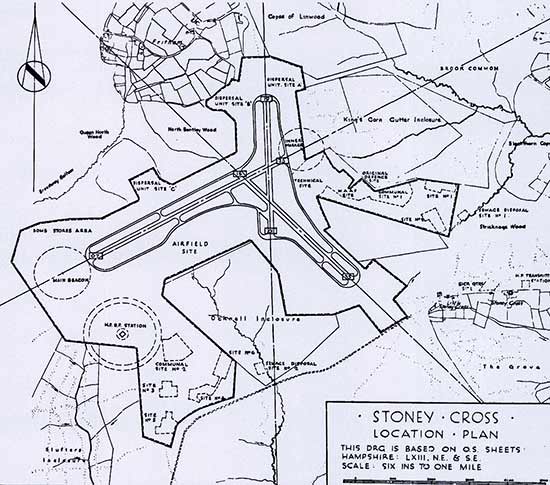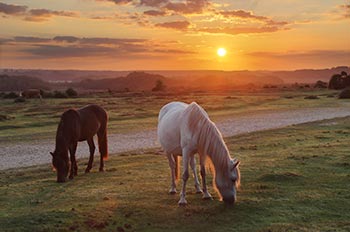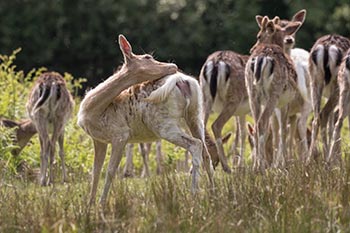Stoney Cross Airfield - its wartime role
(Stoney Cross Airfield can be explored during this 6¼ mile New Forest walk).
Stoney Cross Airfield, also known as RAF Stoney Cross, dates back to the Second World War and was constructed on Ocknell and Stoney Cross Plains, close to the tiny New Forest hamlets of Stoney Cross, which is three miles (5 kilometres) south-west of Cadnam, and Fritham, a little to the north-west of the airfield.
But thankfully, what was Stoney Cross Airfield is not a desolate, post-industrial site, for the New Forest heathlands and woodlands have largely reclaimed their own. There remains, though, much from the airfield to discover and ponder over, and given its wartime vintage, still more about which to think more deeply.
Building activity at Stoney Cross Airfield started early in 1942 and the site was handed over for operational use in November of that year, although it was not ready to accommodate aircraft until January, 1943. It was May, 1943, however, before the majority of essential construction work was completed and August, 1943 before everything was finished.
(Stoney Cross was the last of the three major New Forest, Second World War airfields to be completed - the other two, Beaulieu and Holmsley South, were ready for use in August and October, 1942, respectively).

(Crown Copyright, RAF Museum)
The airfield served the Royal Air Force and the United States Army Air Forces, 9th Air Force. It was a three-runway airfield with the main runway, 2,000 yards (1829 metres) long, on a broadly west-south-westerly / east-north-easterly axis, providing for take offs and landings into the locally prevailing winds.
The second runway, 1520 yards (1390 metres) long, went north-west / south-east, whilst the shortest runway, at 1366 yards (1249 metres) long, ran north / south.
So as to exclude intruding humans, deer, commoners' stock and other animals, the airfield perimeter was encircled by a high wire fence - local commoners were apparently paid £2 per head per annum in compensation for the loss of grazing.
There is, though, at least one recorded instance of an aircraft hitting a New Forest pony, but the aircraft concerned was a transport aircraft so the accident perhaps happened after the end of the war when the fence was maybe not as 'stock proof' as previously.
RAF No. 239 Squadron, previously based at Hurn, arrived at Stoney Cross Airfield in January, 1943, flying P-51B Mustang aircraft; followed in March of that year by No. 26 Squadron, also flying Mustangs, and No. 175 Squadron with Hurricanes.
Use of the airfield at that time was, however, amid on-going construction work, a hardly satisfactory state of affairs, and by early April, 1943 all three of these squadrons had departed for bases elsewhere.
Paratroop dropping and glider towing aircraft arrived in May, 1943, whilst, reflecting rapidly changing wartime circumstances, the airfield was subsequently used by USAAF 9th Air Force personnel flying P38 Lockheed Lightning fighters, USAAF 387th Bomb Group flying B26 Marauder medium bombers, and RAF Transport Command flying Wellington, Stirling, Avro York and Dakota transport planes.
Flying ceased altogether in October 1946 and the airfield was then classified as under 'Care and Maintenance'. It was thrown open in 1947 and closed completely in January 1948 after which some of the camp living areas were used to provide housing for those made homeless by wartime bombing, and for others who were also awaiting Council housing.
Three of the airfield's four large hangars were temporarily used to store auxiliary fire engines - green goddesses - and motor cycles withdrawn from civil defence work, whilst the fourth hangar was used for a while to store surplus grain and other supplies.
The hangars, control tower - situated opposite the entrance to Longbeech campsite - and other buildings were eventually removed, as was much of the concrete from perimeter tracks, runways and other elements of infrastructure, and by 1956 the site had again become Crown Land managed by the Forestry Commission.
A visit to the old airfield today, at first glance, reveals little of particular interest - the last remaining standing structure, a huge green water tower situated by Longbeech campsite, was finally removed in 2004; and the last of the concrete had been stripped from the runways by 2000, to be used as hardcore in road and other types of construction.
But look a little closer and there is still much evidence of this old airfield deep in the Forest.
The outlines of the three runways can still be clearly seen on satellite and other aerial images, and so can some of the dispersal pans where aircraft were left to stand in-between periods of activity.
The runway outlines are also visible on the ground - they are typically at a slightly lower level than the adjacent land as at least some soil was stripped off when the runway surface was removed; they are often bordered on both sides by lines of brambles and gorse; they are (needless to say) absolutely straight; and their grass is often of a lighter shade to that of adjacent land, with patches of gravel, occasional bricks and pieces of concrete showing through.
Aircraft 'frying-pan type' dispersal pans can also still be found, some - such as those in Ocknell campsite - boasting original concrete surfaces.
Look out, too, for the remains of regularly spaced runway light blocks in the grass beside the minor road to Linwood - this road uses the northern part of what was the main runway - and for miscellaneous sections of roadside and other war-time concrete, including the remains of airfield service roads and other facilities within Longbeech campsite.
An interesting information panel is located on the edge of a car park opposite Long Beech Inclosure, sited on concrete initially used as a hard-standing for transport planes.
A - Main runway (with the road to Linwood running along its northern edge)
B - Second runway
C - Third runway
D - Cadman's Pool
E - Janesmoor Pond
F - Ocknell Pond
G - Ocknell Campsite (with the old aircraft dispersal areas clearly visible and now used as hardstandings for caravans)
H - Longbeech Campsite (with the campsite's main service road, originally associated with the airfield, clearly visible)
I - Anses Wood
J - South Bentley Inclosure (with another old service road shown, leading into the wood from the Linwood road)
K - North Bentley Inclosure
L - King's Garn Gutter Inclosure
M - Long Beech Inclosure
N - Ocknell Inclosure
O - Information panel (sited on an area of World War Two concrete now used for car parking)
Find out more about Stoney Cross Airfield
References:
They Flew from the Forest: Alan Brown
Forest Reflections: Edited by Hugh Pasmore and Marie Heinst
New Forest Notes (5th June 2004): Anthony Pasmore
American Air Museum in Britain
History of War
More links
Other related links
Search this site

Sadly, 58 animals were killed - 35 ponies, 13 cows, 8 donkeys and 2 sheep, whilst a further 32 were injured - 3 pigs, 9 donkeys, 11 cows and 9 ponies.
(Forty-three accidents occurred in daylight, 15 at twilight and 101 in the dark. Twenty-seven accidents were not reported by the driver involved).
Here's just one horrific example - Three donkeys killed in collision with van at notorious New Forest blackspot (Advertiser and Times)
Sika deer continue to engage in rutting behaviour, and will do so until December.
Pigs seek out the remains of the acorn crop.
Beech leaves are transformed into a magnificent mosaic of glorious reds and golds. Other deciduous trees, too, take on an autumnal cloak before their leaves fall.
Dragonflies can occasionally be seen on the wing on bright days early in the month.
December
Foxglove leaves survive the winter at ground level, and offer the prospect of colourful summer blooms to come.
Redwings and fieldfares, autumn and winter visitors, gorge on haws and holly berries.
Great grey shrikes and hen harriers hunt over the heaths and other open spaces.
Honeysuckle by the end of the month often shows welcome signs of new growth.



